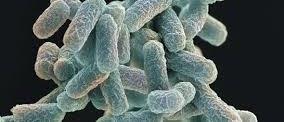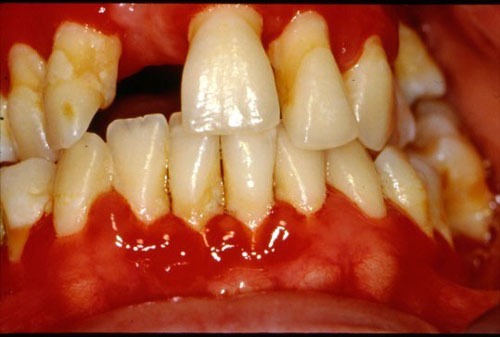The microbiota of dental diseases describes the microorganisms (inclusive of normal flora of the oral cavity and other pathogenic microorganisms) that cause several pathological conditions in the oral cavity – especially as it pertains to the teeth and its associated vessels or structures. The diseases of the teeth include dental plaque, periodontitis, dental caries or decay and gingival diseases. Dental plaque, dental caries, gingivitis and periodontal diseases all result from the microbial actions initiated and carried out by the normal bacterial flora that inhabit the teeth or oral cavity of animals including humans.
Dental plaque is simply the materials that adhere to the teeth. These materials that adhere tightly to the teeth of animals especially humans consists of several substances and microbes inclusive of bacterial cells, fungal cells, salivary polymers, and the extracellular products of microorganisms that habitually inhabit the oral cavity. It is noteworthy that these materials (i.e. the plaque on the teeth) are made up of a high proportion of bacteria that also contribute in causing other dental-disease conditions.
Plaque is a naturally-occurring or constructed biofilm that is comprised of bacteria and are normally found on the surfaces of the teeth. The plaque subjects the teeth and gingival tissues surrounding the teeth to high concentrations of metabolites produced by bacterial cells. These metabolites finally culminate to the medical condition known as dental disease. Streptococcus sanguis and Streptococcus mutans are the dominant bacterial species in dental plaque and they have also been implicated in order dental diseases or infections such as gingivitis or gingival diseases. Lactic acid bacteria are other group of bacterial species that are implicated in other dental infections inclusive of dental caries.
Dental Caries is the destruction of the enamel of the teeth due to bacterial activities. It is usually initiated by direct demineralization of the enamel of teeth due to lactic acid and other organic acids which accumulate in dental plaque following microbial activities. The fermentation of sugars and other carbohydrates in the diet of the host by Lactic acid bacteria produces lactic acid which eventually cause the demineralization of the teeth and this generally result in dental caries. Gingivitis or gingival disease is a type of periodontal disease that affects the supporting structures of the teeth such as the enamel, periodontal membrane and the alveolar bone.
Gingivitis is a dental disease or infection that is confined to the gum and has little or no influence on the teeth itself. Both Gram-positive bacteria (e.g. Streptococci) and Gram-negative bacteria (e.g. Bacteroides) are implicated as causative agents of gingival diseases. When proper care is not given to the teeth, bacteria builds up on the gum and their activities makes the teeth prone to other microbial infections aside the devastating dental problem they initiate. Irrespective of the fact that dental infections or diseases pose no remarkable life-threatening scenario in the host, it is vital to ensure proper upkeep and care of the teeth in order to avoid the associated diseases caused by the enormous microbial challenge that attack the teeth.
References
Barrett J.T (1998). Microbiology and Immunology Concepts. Philadelphia, PA: Lippincott-Raven Publishers. USA.
Beck, J. D., Slade, G. and Offenbacher, S. (2000). Oral disease, cardiovascular disease and systemic inflammation. Periodontol, 23, 110-20.
Beers M.H., Porter R.S., Jones T.V., Kaplan J.L and Berkwits M (2006). The Merck Manual of Diagnosis and Therapy. Eighteenth edition. Merck & Co., Inc, USA.
Brooks G.F., Butel J.S and Morse S.A (2004). Medical Microbiology, 23rd edition. McGraw Hill Publishers. USA.
Champoux J.J, Neidhardt F.C, Drew W.L and Plorde J.J (2004). Sherris Medical Microbiology: An Introduction to Infectious Diseases. 4th edition. McGraw Hill Companies Inc, USA.
Davey M.E and O’toole G.A (2000). Microbial biofilms: from ecology to molecular genetics. Microbiol. Mol. Biol. Rev, 64, 847-867.
Gillespie S.H and Bamford K.B (2012). Medical Microbiology and Infection at a glance. 4th edition. Wiley-Blackwell Publishers, UK.
Jenstch, H., Pornowski, R., Kundi, G. and Gocke, R. (2003). Treatment of gingivitis with hyaluronan. J. Clin. Periodontol.,30, 159-164.
Mayooran B, Robin S and John R.T (2000). Dental caries is a preventable infectious disease. Aust. Dent. J, 45, 235-245.
Trahan L.X (1995). A review of its action on mutans streptococci and dental plaque–its clinical significance. Int. Dent. J, 45, 77-92.
Warren L (2008). Review of Medical Microbiology and Immunology. Tenth edition. McGraw Hill Companies Inc, USA.
Wilson B. A, Salyers A.A, Whitt D.D and Winkler M.E (2011). Bacterial Pathogenesis: A molecular Approach. Third edition. American Society of Microbiology Press, USA.
Discover more from Microbiology Class
Subscribe to get the latest posts sent to your email.





